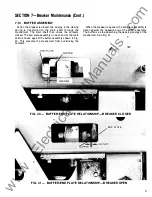
SECTION 6-lnterlocks (Cont.)
FIG.
1 5
RACKING SCREW COVER INTERLOCK
CLOSED POSITION
6.2 POSITIVE INTERLOCK
The function of the positive interlock is to keep the
breaker trip-free while it is being racked in or out between
the CONNECTED and TEST positions.
The positive interlock is located on the breaker left side
as shown in Fig . 1 6. As the breaker moves between the
CONNECTE D and TEST positions, the positive interlock
engages with a ramp cam located in the breaker compart
ment. This cam raises the interlock lever assembly caus
ing the trip shaft to rotate and prevent the trip latch from
engaging with the secondary latch assembly roller. The
breaker is held trip-free and cannot be closed during this
interval .
6.3 CLOSING SPRING INTERLOCK
The function of the closing spring interlock is to dis
charge the closing spring as the breaker is bei ng racked
out of its housing. This eliminates the hazard of a com
pletely charged breaker being discharged after the breaker
is removed from its compartment.
The operation of the closing spring interlock is shown in
the two pictures for Fig. 1 7. The racking mechanism arms
and the crank are connected to a common shaft. As the
breaker is racked out a pin attached to the crank moves
through a slot tint he m echanism linkage. The linkage is
connected to a lever which engages with a pin on the
closing solenoid armature linkage. When the racking
mechanism approaches the DISCONNECT position, the
16
•
INTERLOCK
FIG. 1 6 - POSITIVE INTERLOCK
crank pin reaches the end of the slot in the linkage.
Continued motion of the racking mechanism causes the
linkage to rotate the lever which moves the closing sole
noid armature forward. The armature linkage then releases
the prop, d ischarging the closing spring.
The Closing Spring interlock should be adjusted to
cause the closing spring to discharge when the racking
mechanism is a minimum of 1 and a m aximum of
2112
turns short of the fully racked out position. I n this position
the racking handle can no longer be turned. If adjustment is
requ i red, use the li nkage adj usting screws shown in
Fig. 1 7.
Note: - Undue force on the racking handle at the fully
racked out position wi l l cause the lever to m ove past the
pin on the armatu re linkage. This will bind u p the overall
interlock. Under these conditions, conti nued application
of this force wi ll deform the linkage assem bly.
www
. ElectricalPartManuals
. com




































